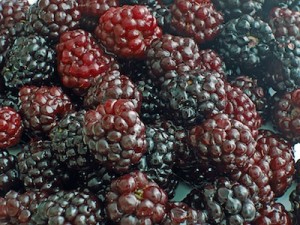Blackberries are easy to plant and once established, require little maintenance after the first year. They are cold hardy, withstanding temperatures well below zero when properly tended. Plants will live for decades, although individual canes die out after two years and will need to be removed to avoid disease. They will produce well year after year, even in poor soil.
General Info:
 Blackberries are members of the rose family, like raspberries, strawberries, and fruit trees – including apples, pears, cherries and plums. Stems of blackberries are called canes. New canes sprout each year. First year canes – called primocanes – don’t bear fruit. Only the second year canes – called floricanes—bear fruit. After fruit bearing, the floricanes die off and need to be removed. Some wait to cut them out until after the third year to give the plant some structural support.
Blackberries are members of the rose family, like raspberries, strawberries, and fruit trees – including apples, pears, cherries and plums. Stems of blackberries are called canes. New canes sprout each year. First year canes – called primocanes – don’t bear fruit. Only the second year canes – called floricanes—bear fruit. After fruit bearing, the floricanes die off and need to be removed. Some wait to cut them out until after the third year to give the plant some structural support.
Blackberries come thornless and in varieties that have hook-shaped thorns. Most thornless varieties produce large berries but are bland in flavor, where varieties with thorns have smaller berries but an intense flavor. One thornless berry, the Apache, has been developed with both huge berries and great flavor.
Planting:
Blackberries can be grown three different ways: individual plants, trellised rows, or as a hedge. Any of these methods will give you the beautiful berries you are looking for. Your choice will depend on the amount of space available for your berry patch.
Individual plants: With limited space, this is the way to go. Individual plants have ten to twelve canes. They can be pruned so that the canes are layered, much like some hair cuts, for ease in harvesting. They can be trained against a small, fan-shaped trellis for support. Plants can also be grown in large containers at least twelve inches high and twelve inches across, but fifteen-gallon containers are recommended. Plastic containers are best as they maintain moisture without holding heat in, plus they are less expensive than other containers. They also drain well when properly prepared, which keeps plants from being in standing water.
Trellised rows: Great for large sunny areas that are some distance away from your vegetable garden. Trellises provide support for your canes and allow thme to be trained well.
Hedges: True simplicity reigns in free-formed hedges. They allow the canes to support themselves and make a beautiful divider for your yard, allowing for garden rooms that provide private spaces in your yard.
Regardless of the planting choice, berries need fertile, well-drained soil in a sunny location. They will grow in less than optimal conditions, but they will not produce as big a crop as they would when conditions are prime.
Blackberries can be planted in spring or fall when soil is dry enough to dig holes or trenches. Holes or trenches should be four to six inches deeper than the root ball and wider than the roots are long. This will allow loose soil around the root ball so new roots can easily develop. The better prepared your planting area, the better blackberries will grow.
Canes need to be planted so the crowns (where the roots join the stem) are an inch or two below the surface of the soil. Spread out roots evenly while back filling the holes or trench. Water well. If you choose to add fertilizer, only use a liquid root stimulator at this time.
Mulch young berries eighteen to twenty inches out from canes to help retain moisture and assist with weed control. Mulch can be wood bark, dry leaves, or grass clippings. The first year you may want to use the wood bark, changing to dry leaves or grass clippings in following years, as they are free. If you choose to plant a hedge you will want to mulch heavily around the whole row about twenty inches out from the base of hedge.
Weed control – This is handled by the continued mulching described above. If you find any tree saplings coming up amid the mulch, clip them off just below ground level. This may not kill the tree, but will keep it from interfering with your berry patch for now. You may have to repeat this process in succeeding years.
Pruning – Blackberries can be cut back to shorten and layer canes so you are able to harvest all the berries. Trimming wayward canes is a good idea so the berries patch doesn’t hinder the lawn maintenance and to maintain the appearance of the patch. But the only necessary pruning is to cut out dead second year canes immediately after harvesting your blackberries. I have found pruning done in the new moon is best, as the sap is at its lowest point when the moon is dark. Cut the old canes off as close to the ground as possible. Wearing heavy, leather gloves will protect hands from cuts and gouges by the thorns.
Harvesting:
Harvesting usually lasts two to three weeks and can start in mid to late June, depending on weather conditions and when they bloomed. Picking your berries should be done early in the morning, just as the dew begins to dry. The sugar is highest in the plants and your berries will be their sweetest then. Pick with a breaking motion, not pulling, as this tends to be easiest. If a berry doesn’t come free easily, it isn’t yet ripe so leave it for another day.
Freezing is the best way to preserve blackberries; if correctly prepared they will keep for a year or longer. You can also make jams, jellies, desserts and tasty wines from your blackberries.
Diseases and Pests:
The biggest threats to blackberries are the birds. It seems that every bird in the country loves to eat them. Most gardeners will find that these berries are prolific enough that sharing with the birds is no problem.
Mammals don’t seem to bother them much, especially if you have barking dogs in your yard or the neighbor’s yard nearest your berry patch. They tend to scare away most furry critters that would eat your berries. If you do have issues with birds or furry creatures, either be prepared to share or find a bird friendly netting to cover the plants with.
Pests and diseases are listed on the Integrated Pest Management Center web site. On their site you will also find extensive information on what to look for and how to treat various blackberry bests.
Plant, pick, and enjoy your berries. Try some with a sprinkle of sugar and a chug of fresh cream. Happy gardening!
© 2011 Off the Grid News
